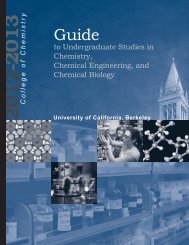Newsjournal body.qxp - College of Chemistry - University of ...
Newsjournal body.qxp - College of Chemistry - University of ...
Newsjournal body.qxp - College of Chemistry - University of ...
Create successful ePaper yourself
Turn your PDF publications into a flip-book with our unique Google optimized e-Paper software.
NMR Goes Mobile<br />
Homeland security experts may soon be getting a<br />
valuable new tool for identifying the chemical<br />
constituents in suspicious substances. A<br />
portable device makes it possible for the first time ever to<br />
take high-resolution NMR spectroscopy—one <strong>of</strong> the<br />
principal tools for chemical analysis—out <strong>of</strong> the laboratory<br />
and into the field for use on samples <strong>of</strong> any size.<br />
“Our device does not compete with the superconducting<br />
magnets that are used to study proteins, but there are many<br />
applications, besides homeland security, where you can’t<br />
bring samples from the field to the laboratory, including<br />
medical diagnosis, archaeological analysis, or the exploration<br />
<strong>of</strong> objects in space, like planets or moons,” said chemical<br />
engineering graduate student Vasiliki Demas, one <strong>of</strong> the<br />
co-authors <strong>of</strong> a paper describing the portable NMR device,<br />
which appears in the April 8, 2005 issue <strong>of</strong> the journal Science.<br />
Demas is a member <strong>of</strong> the research groups <strong>of</strong> chemical engineering<br />
pr<strong>of</strong>essor Jeffrey Reimer and chemistry pr<strong>of</strong>essor<br />
Alexander Pines.<br />
Other principal authors <strong>of</strong> the Science paper were<br />
Bernhard Blümich, Federico Casanova and Juan Perlo, <strong>of</strong> the<br />
Aachen Institute, and Carlos Meriles, a physicist now at City<br />
<strong>College</strong> <strong>of</strong> New York, in addition to Reimer and Pines.<br />
Blümich is the co-inventor <strong>of</strong> the NMR Mobile Surface<br />
Universal Explorer, Reimer is an expert in NMR technologies<br />
for materials engineering, and Pines is one <strong>of</strong> the world’s<br />
foremost authorities on NMR spectroscopy.<br />
NMR is a phenomenon involving the atomic nuclei <strong>of</strong><br />
molecules in which at least one proton or neutron is<br />
unpaired. The imbalance causes such nuclei to spin on an<br />
axis like miniature tops and gives rise to a magnetic<br />
moment, which means the nuclei act as if they were bar<br />
magnets with a north and south pole. When a sample is<br />
exposed to a strong external magnetic field, these spinning<br />
“bar magnets” attempt to align their axes along the lines <strong>of</strong><br />
magnetic force. The alignment is not exact, resulting in a<br />
wobbly rotation about the force lines that is unique for each<br />
type <strong>of</strong> nuclei. If, while exposed to the magnetic field, the<br />
nuclei in a sample are also hit with a radi<strong>of</strong>requency (rf)<br />
pulse, they will absorb and re-emit energy at specific<br />
frequencies according to their individual rates <strong>of</strong> rotation.<br />
RESEARCH Matters<br />
These frequencies show up in an NMR spectrum as distinct<br />
peaks <strong>of</strong> varying height that, like a set <strong>of</strong> fingerprints, can be<br />
used to identify the sample’s constituent nuclei.<br />
Because the rate at which resonating nuclei realign<br />
themselves with magnetic field lines is heavily influenced by<br />
their neighboring nuclei, NMR can also be used to provide<br />
detailed information on the structural, dynamic, and spatial<br />
relationships <strong>of</strong> atoms in a sample. Deviations from<br />
reference peaks on the NMR spectrum, called “chemical<br />
shifts,” reflect different concentrations <strong>of</strong> a sample’s<br />
constituent nuclei and can be used to positively identify the<br />
molecular composition and chemical nature <strong>of</strong> the sample.<br />
Until recently, high resolution NMR spectroscopy could<br />
only be done by placing a sample inside the bore <strong>of</strong> a very<br />
large stationary magnet that produces a strong, uniform<br />
magnetic field. Portable NMR systems with open, singlesided<br />
probes, have been built, but the lack <strong>of</strong> uniformity in<br />
their magnetic fields limits them to low resolution.<br />
The scientists applied the ex-situ technique in a portable<br />
single-sided sensor device, which, for these experiments,<br />
was configured for high resolution NMR spectroscopy. Two<br />
concentric U-shaped permanent rare earth magnets<br />
(Neodymium-Iron-Boron) were arranged to create a magnetic<br />
“sweet spot” about seven millimeters above the active magnet<br />
surface. In this sweet spot, the static magnetic field is<br />
parallel to the plane and reaches a field strength <strong>of</strong> 0.2 Tesla.<br />
The rf pulses were generated through a rectangular rf coil<br />
that is shaped and positioned with the inner <strong>of</strong> the rare earth<br />
magnets to optimize the interaction between the static<br />
magnetic field and the magnetic fields<br />
generated by the rf pulses. When a sample<br />
is placed in the sweet spot and hit with a<br />
carefully orchestrated series <strong>of</strong> rf pulses,<br />
the result is an NMR spectrum with a<br />
sharp enough resolution to reveal<br />
chemical shifts <strong>of</strong> eight parts per million<br />
within three minutes after sample testing<br />
begins.<br />
. . . . . . . . . . . . . . .<br />
From Berkeley Lab News Releases,<br />
http://www.lbl.gov<br />
by Lynn Yarris, LBNL<br />
MOBILITY. The<br />
portable NMR<br />
instrument currently<br />
resides in a copper<br />
room to dampen<br />
electromagnetic<br />
impulses from<br />
surrounding lab<br />
instrumentation.<br />
Rachel Martin is one<br />
<strong>of</strong> the ex situ team<br />
members in the<br />
Pines group.<br />
. . . . . . . . . . . . . . . . . . . . . . . . . . . . . . . . . . . . . . . . . . . . . . . . . . . . . . . .NEWSJOURNAL 2005<br />
11




